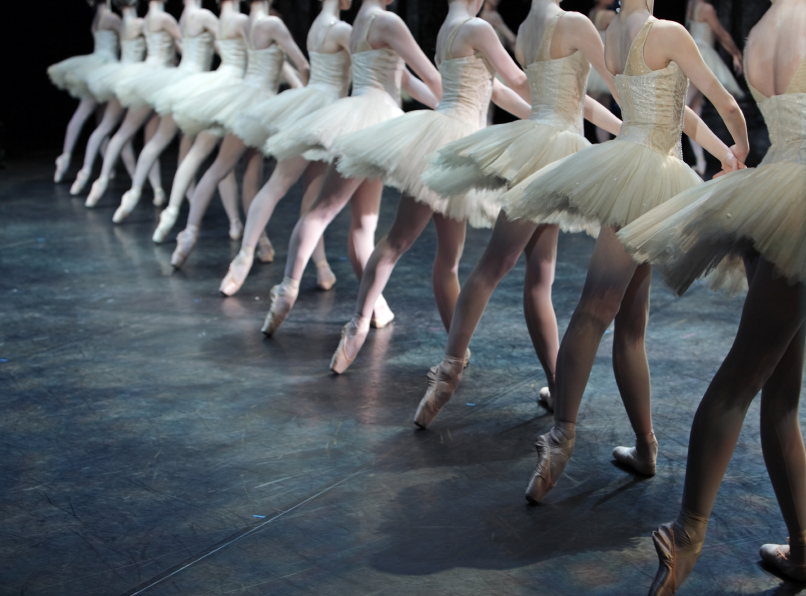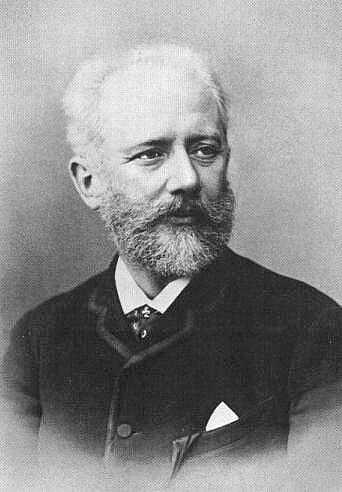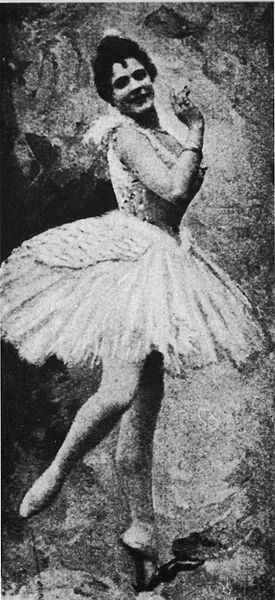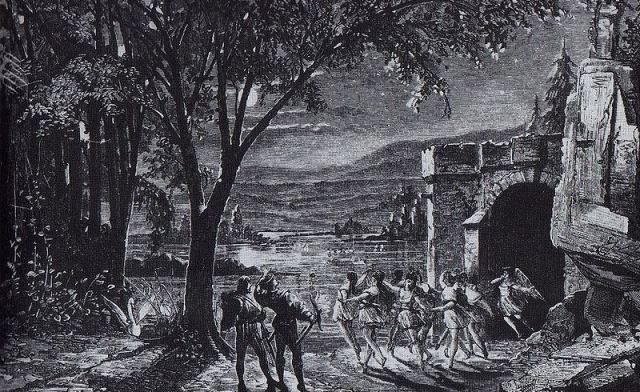
Swan Lake – A History
Written by Rachel Wunder for the Gelsey Kirkland Academy
Swan Lake: A Cherished and Long-Enduring Ballet
Swan Lake is a classic, treasured ballet which tells the story of a prince who encounters a beautiful swan transformed from a human princess by a wicked sorcerer’s curse. Throughout the story, the ballet powerfully conveys to the audience through the mutual pursuit of love between the prince and the swan queen, the theme of the soul’s struggle towards idealized love and sacrifice against its imprisonment in the body of a “swan creature”. A well-known and beloved ballet, Swan Lake is found in the repertory of ballet companies around the world. Composed by Pyotr Ilyich Tchaikovsky from 1875-1876, the original production “The Lake of the Swans” premiered in March of 1877 by the Bolshoi Ballet at the Bolshoi Theatre in Moscow.
Origins and influences
The origins of the Swan Lake story are unclear. Fyodor Lopukhov (chief choreographer of the Mariinsky Theatre) called Swan Lake a “national ballet” because of swans “who originate from Russian lyrically romantic sources” and from Slavonic ring dances. Lopukhov thought “both the plot of Swan Lake, the image of Swans and the very idea of a faithful love are essentially Russian.” There are very few records about the first production of Swan Lake, and regrettably there is no clarity on the author of the libretto. The plot appears to be based on tale by German author Johann Karl August Musaus, “The Stolen Veil”, though this story only generally covers the plot of Swan Lake. A Russian folktale “The White Duck” is similar to the ballet and could have also been a source. Colleagues of Tchaikovsky would later remember in an interesting insight into the source of the ballet’s leading male character (Prince Siegfried), that the composer was interested by the tragic life of Bavarian King Ludwig II, who was possibly a direct or indirect archetype for the prince.
Tchaikovsky’s Research and Composition
 |
| Pyotr Ilyich Tchaikovsky |
From the beginning of the 19th century to the 1890′s, ballet scores were written by “specialists”, which were composers who knew ballet music as was the particular style of the period. Tchaikovsky studied these specialist composers such as Ludwig Minkus and Cesare Pugni before composing Swan Lake. Tchaikovsky had previously not appreciated the specialist style until he studied it and found its intricacies and “infectious” melodies. He respected the composers of his time which included Adolphe Adam, Leo Delibes, and Ricardo Drigo. Tchaikovsky wrote to Sergei Taneyev (his protégé) “I listened to the Delibes ballet “Sylvia”… What charm, what elegance, what wealth of melody, rhythm and harmony. I was ashamed, for if I had known of this music then, I would not have written Swan Lake”.
Tchaikovsky also respected Adolphe Adam’s 1844 score for Giselle which incorporated a technique known as leitmotif – “associating certain themes with certain characters or moods”, a technique Tchaikovsky would use in Swan Lake and later in The Sleeping Beauty. In his composition of the Swan Lake score Tchaikovsky used music from The Voyevoda, an opera he had stopped writing in 1868. The “Grand Adage” or “Love Duet” pas de deux from the 2nd act of Swan Lake was from an aria of the opera, and additional numbers from the unfinished work were included in the ballet as well.
Tchaikovsky was excited by the opportunity to work on the large task of composing Swan Lake, and would achieve a rare feat by the ballet’s composition when he completed it within one year. However, when the score was finished by April of 1876 and rehearsals began, choreographer Julius Reisinger (ballet master of the Ballet of Moscow Imperial Bolshoi Theatre) removed several numbers he thought “unsuitable for ballet”, and even went to so far as to choreograph to other music! It was only after Tchaikovsky’s objections that the pieces were reinstated.
Premiere and Reception of Swan Lake Original Production
 |
| Pierina Legnani as Odette in Marius Petipa and Lev Ivanov’s revival of Swan Lake, St. Petersburg, 1895. |
The original production of Swan Lake was premiered on Friday, March 4th 1877, as a benefit performance for ballerina Pelageya “Polina” Karpakova, who performed the role of Odette. However, the premiere “was not well received with near unanimous criticism concerning the dancers, orchestra, and décor.” Tchaikovsky’s score was forgotten in the midst of the general criticism, and instead of recognizing what it brought to the ballet, it was thought to be too complicated. Many of the critics, more familiar with “spoken melodrama” instead of music or ballet called Tchaikovsky’s score “too noisy, too ‘Wagnerian’, and too symphonic.” A certain rather brutal critic by the name of Tyler Grant went to so far as to call the premiere “utter hogwash” with choreography “unimaginative and altogether unmemorable”.
There were several contributing factors that affected the success of the production, one of them being the fact that the story of Swan Lake had German origins which were “treated with suspicion while the tale itself was regarded as “stupid” with unpronounceable surnames for its characters”. In addition, the dancer who performed the role of Odette, and most probably Odile as well was a secondary soloist and “not particularly convincing”. Modest Tchaikovsky, the brother of P.I. Tchaikovsky, shared his reflections on the matter of the failed première: “The poverty of the production, meaning the décor and costumes, the absence of outstanding performers, the Balletmaster’s weakness of imagination, and, finally, the orchestra…all of this together permitted [Tchaikovsky] with good reason to cast the blame for the failure on others.”
Swan Lake’s Continued Productions and Revivals
Despite the criticism of the premiere, an inevitably undesirable reputation, and claims of the music being too “complex” to be used for a ballet piece, Swan Lake continued to be performed, and as we know today is one of Tchaikovsky’s most important contributions to the ballet world. When original choreographer Julius Reisinger left the Bolshoi theatre in 1879, a new balletmaster by the name of Joseph Peter Hansen revived the ballet in 1880 and again in 1882, slightly altering the original version both choreographically and musically which resulted to a more favorable reception, though it did not make it a success. A final performance in 1883 brought the number of Swan Lake productions to a total of forty-one performances, a significant number considering the premiere of Swan Lake was virtually a failure. Excerpts of the ballet continued to be performed throughout the 1880’s throughout Europe, and Tchaikovsky recorded in his diary “a moment of absolute happiness” when he conducted two concerts of the second scene of Swan Lake in Prague. Interest in the ballet continued as balletmasters and choreographers which included even Marius Petipa discussed and planned attempts to revive Swan Lake. After Tchaikovsky’s death in 1893, Ricardo Drigo, with the approval of Modest Tchaikovsky, revised the original score (a revised score which many ballet companies use today), and shortly thereafter with choreography by Lev Ivanov of the Imperial Ballet, a memorial concert comprised of the second act of Swan Lake was performed to great acclaim. Between 1894 and1895 Italian dancer Pierina Legnani enchanted audiences in the role of Odette with her stunning technique demonstrated by the execution of thirty-two fouettes en tournant in the final scene, which was at the time the most that had ever been performed.

The ballet continued to be improved during this time, with Ivanov and Petipa working together on re-choreographing and staging a revival. Modest Tchaikovsky edited the libretto, changing the finale of the ballet from a hopeless tragedy where both Odette and the Prince drown by the power of Von Rothbart (which was the ballet’s original ending for the 1877 premiere) to an alternative ending where the lovers choose death in order to break the curse binding them and are afterwards reunited. The new version of Swan Lake premiered on January 27th of 1895, with Pierina again dancing as Odette/Odile. Though there were few performances during the last years of the 1890’s, the reception of the new version was a positive one, distinguishing both Pierina and her successor in the role. In now more modern day productions it is still the 1895 production of Petipa/Ivanov/Drigo that has stood the test of time, with the majority of traditional choreography being preserved.
Swan Lake: From Failure to Triumph
Swan Lake continues to be influential both inside and out of the ballet world, moving and exciting audiences and inspiring popular culture. It is a story ballet whose origins are speculated, a ballet whose music was created by a passionate and determined composer who successfully wrote it within a year. Despite Tchaikovsky’s enthusiasm for the work the ballet had a disappointing start, (the score receiving criticism from the balletmaster so that he even began choreographing to the music of Ludwig Minkus), and the completed ballet’s premiere resulting in a catastrophe of criticism from audience and press alike, voicing their lack of appreciation toward the efforts put into its creation, public distaste for the story and its characters, and a general denunciation that included even the disheartened composer himself. But what was the spark of enduring and endearing genius in the early days of Swan Lake? Were the continued performances, despite the negative reception and tragic story, a foreshadowing of its future success? The persistent efforts to revise the story, choreography, and score, the collaborative effort to make it a success in the public eye, and the continued technical advancement of the dedicated artists, choreographers, composers and dancers who all made their generous contributions brought this well-known and loved ballet to where it is today. The ballet world would have certainly been dealt a crushing blow by the loss of this tremendous work had it not been for the continued attempts to make what was once a poorly received ballet an accepted classic fixture of ballet repertory everywhere.
